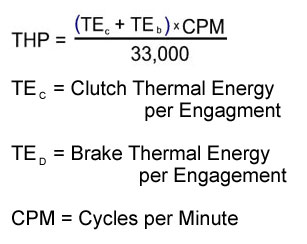Selecting the Right Clutch Brake
Understanding horsepower, torque, thermal energy and Inertia
There are many pieces to selecting the correct clutch brake for a particular application. It uses many of the components of selection for gear reducers, chain and belt drives and motors, but has some very important differences.
To start the selection we must have some information of the application.
What is the application – type of machine, motion required, environment, vertical load up or down, acceleration and deceleration time, soft start, or high inertia load.
What is the cycle rate – how many indexes per minute, day, hour.
What is the duty cycle – time engaged vs time off
What is the torque requirement for starting and stopping the load. They are often different.
There are two parts to determine the total torque required.
Cyclic Inertia – Cyclic inertia of all components to be accelerated and decelerated must be determined and reflected back to the clutch brake through the ratio. This would include the inertia of the driven component as well as the items in the drive train from the output shaft of the clutch on. These could be shafts, couplings, gears, sprockets pulleys, flywheels, and more. Each component inertia should be calculated, and reflected back through the ratio to the clutch brake output. This torque will be the same for both clutch and brake calculations. Inertia on the input side of the clutch brake is not involved.
Load torque – In addition to inertial torque load torque should be determined and added to the inertial torque. Load torque is the torque to overcome the load. For instance a vertical conveyor will have a certain torque requirement just to hold the load. This must be added to the inertia torque. The load torque may be different for the clutch and the brake. If a load must be lifted during acceleration it will be added to the clutch required torque and removed from the brake required torque, but if lowering it will be added to the brake torque and deducted from the clutch torque. Note the torque must be reflected through the ratio back to the clutch brake.
Clutch brakes should be sized for the required loads and not significantly oversized. Over sizing a clutch brake can cause as many problems as under sizing. Over sizing, especially the brake can add severe loads to all of the drive line components breaking couplings, belts or shafts.
System efficiency – Efficiency of all drive and load components must be included in the calculations. Typically they will add to the clutch required torque and deduct from the brake torque requirement.
Thermal Horsepower – A second component for sizing is thermal energy, or heat that must be dissipated. In simple terms when a clutch is engaged to accelerate a load up to speed half of the energy goes to acceleration and the other half becomes heat. When the brake is engaged to stop the load all of the rotary motion energy is converted to heat in the brake. The thermal requirement for the clutch and brake must be calculated. This is normally shown as thermal horsepower in the specifications.






